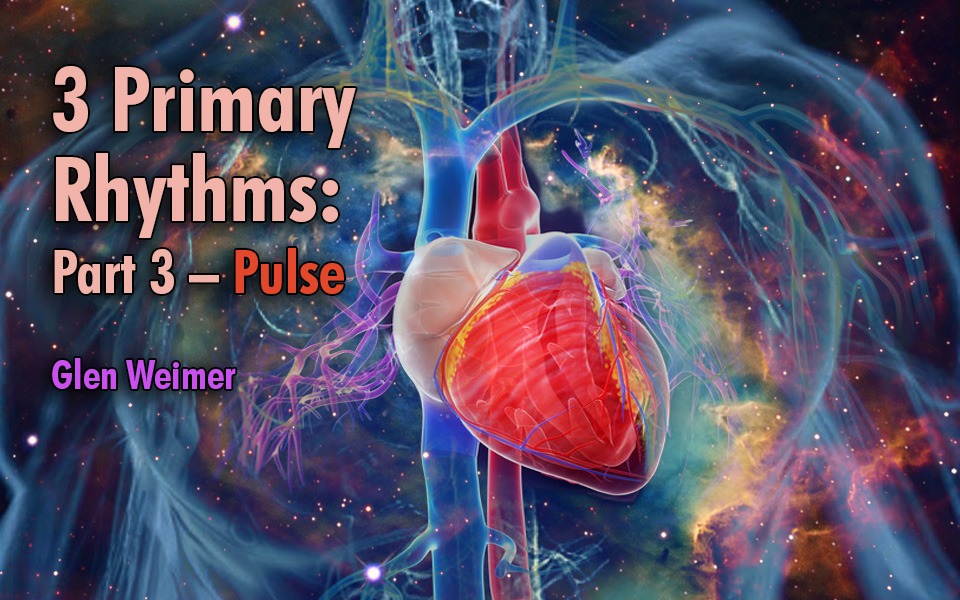Please note: this is the third installment of a 4-part blog. (see Parts 1 & 2)
The Heart Beat or Pulse
The second rhythm I would like to discuss is the pulse or heartbeat. The heartbeat is tied directly to respiration. It is hard to increase your heart rate without affecting your breathing and vice versa. The heart pumps oxygen and nutrient-rich blood that it gets from the lungs to every part of the body and spent/oxygen-depleted blood back from the far reaches of our bodies and sends it off to the lungs to get recharged. This pumping establishes a pressurization within the tissues and spaces of the body. The pressure differentials between these body spaces, more than the heart alone, pumps the blood everywhere. Physical activity increases the heart rate and respiration of the lungs which in turn increases the amount of energy available for use in activities or for healing/repair.
“The goal of life is to make your heartbeat match the beat of the universe,
to match your nature with Nature.” ~ Joseph Campbell
HeartMath Research
Scientific research from the HeartMath Institute “suggests that the heart also is an access point to a source of wisdom and intelligence that we can call upon to live our lives with more balance, greater creativity and enhanced intuitive capacities”. For more than 25 years, they have explored the physiological mechanisms by which the heart and brain communicate and how the activity of the heart influences our perceptions, emotions, intuition, and health. Their studies have shown that heart coherence, an optimal physiological state, is associated with increased cognitive function, self-regulatory capacity, emotional stability, and resilience.[1]
Coherence
In my practice, we work with establishing coherence in the total mind-body system through dialogue and hands-on bodywork. There are two aspects of the physical heartbeat that I utilize regularly: gentle, rhythmical pulsing of an organ or area of he body to increase the blood flow and thereby available energy in that area; and synchronizing or normalizing the pulse between two separate areas of the body which facilitates energetic and cellular communication. Just as with the breath, this allows toxic waste to get flushed from the cells and nutrients to come back to those tissues for self-healing.
To work with this ourselves, we are going to use the rhythm of syncopated breathing to stimulate the pulse. One of my favorite meditation explorations is Diaphragm Synchronization which works with our body’s functional diaphragms (transverse tissues that separate one body cavity from another). This frees up frozen tissue, relaxes the body, and stills the mind very quickly. It also re-establishes a communication of coordinated motion between all five of the body spaces: head, neck, chest, belly, and pelvis.
PULSING EXPLORATION
Here we are going to work with just one of these diaphragms, the shoulder girdle. If possible breathe through your nose with your mouth closed and your tongue pressed gently to the roof of your mouth. In a relaxed seated position (on a floor cushion or in a chair) with your spine erect and not leaning against any support, slowly increase the depth of your breathing. Notice your shoulders raise with each In-Breath and fall with each Out-Breath.
Gradually allow your breathing to become more accentuated. Breathe at a pace and rhythm that is comfortable to you. The breath can speed up and even become more syncopated/accented. Explore different speeds, rhythms, and movements to pump blood into different areas. The shoulder girdle can move forward, rounding the chest, or back, opening the chest. And the motion can be up and down or forward or back. Do this exercise for 30-seconds to several minutes.
You may get light-headed from the increase in oxygen, don’t overdo it! End on an Out-Breath, completely emptying your lungs, and hold for several seconds. Resume breathing when your body wants a breath. Take a moment to notice how you feel. What changed from before doing the exercise?
REMEMBER: ALWAYS LISTEN TO WHAT IS COMFORTABLE FOR YOUR BODY!
Continue reading. Go to 3 Primary Rhythms: Part 4 – Fluid Tide
[1] McCraty, Ph.D. , Rollin , Science of the Heart: Exploring the Role of the Heart in Human Performance Volume 2 – www.heartmath.org
Disclaimer:
The information featured on this site is provided for information and education purposes only and is not intended to replace the advice of your doctor or health care provider on medical and/or health-related issues.
You should not use the information on this site for diagnosis or treatment of any health problem or as a substitute for medication or other treatment prescribed by your physician or health care provider.
Submit your review | |

